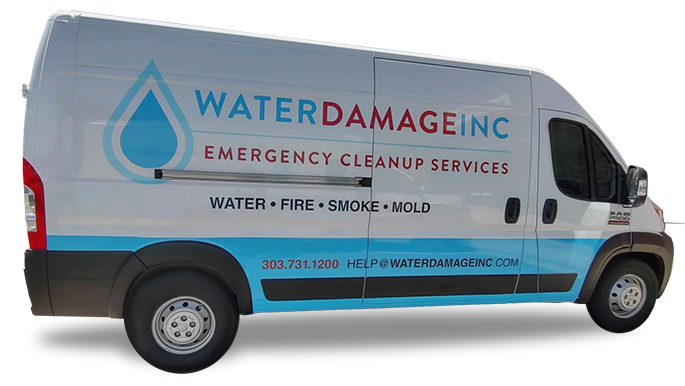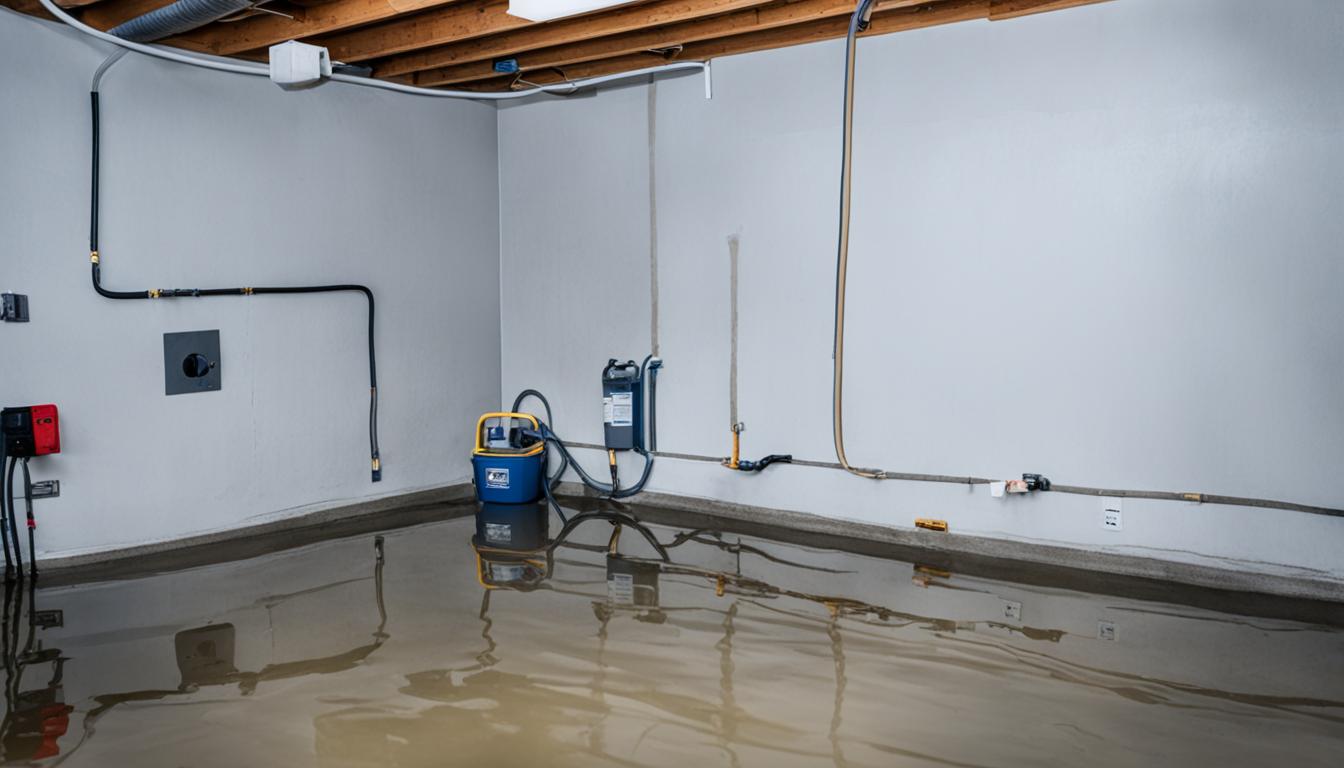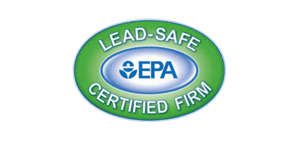Each year, more than 14,000 people deal with water damage at their homes or workplaces. That means someone faces an emergency every four minutes in our country. Among these, basement flooding is quite common, leading many to wonder if their flooded basements will dry up by themselves.
Relying only on the air to dry out a basement is risky. It could harm the house’s structure. Not handling a flooded basement quickly can lead to expensive repairs. It’s not just about removing water. We also need to stop moisture damage that you can’t see right away.
A flooded basement won’t dry out on its own without causing issues. Materials like drywall and carpets can stay damp and grow mold. This can lead to health problems and damage your home. So, it’s wise to bring in experts for water damage cleanup instead of hoping it’ll dry on its own.
Key Takeaways
- Basement flooding requires prompt action to prevent lasting water damage.
- Self-drying basements are a myth; professional equipment is essential.
- The risks of a moist environment include mold, health hazards, and structural decay.
- Complete drying is a detailed process, not just visible water extraction.
- Ignoring water damage can result in higher restoration costs and risks.
- Professional water damage restoration is key to ensuring a safe, dry basement.
Risks and Realities of Basement Flooding
Understanding the risks of basement flooding is key for homeowners. It’s not just about the mess; a little water can lead to big problems. Floors can bend, walls can bulge, and things like heaters can break. Water damage restoration is essential to fix these issues by fast water removal. If not handled quickly, your home’s foundation and safety could be at risk.
Flooded basement cleanup right after a flood is crucial. It can cut down health dangers a lot. Wet areas can grow bacteria, mold, and mildew, which are bad for health. Cleaning up means drying, disinfecting, and making everything sanitary for safe living. Experts have the right tools and know-how to clean up thoroughly.
The impact of flooding can last a long time if not addressed right. Below is a table showing the difference between quick expert help versus late or DIY cleanups:
| Cleanup Approach | Immediate Water Damage Restoration | Delayed/DIY Cleanup |
|---|---|---|
| Structural Damage Risks | Greatly reduced | Potentially significant over time |
| Health Hazard Consequences | Minimized through professional-grade sanitization | Increased risk of mold and bacteria growth |
| Overall Restoration Efficiency | High efficacy with professional-grade equipment | Varies, often compromised by lack of proper tools and knowledge |
| Cost Implications | Potential cost savings by preventing further damage | Risk of higher costs due to incomplete cleanup or secondary damage |
The aftermath of flooding is more than just water. Homeowners must see the value in water damage restoration services. They repair and shield homes from risks of basement flooding. Fast and skilled flooded basement cleanup prevents many problems. This ensures a quick return to a safe, cozy home.
Immediate Actions to Take in a Flooded Basement
When your basement floods, acting quickly and wisely is key. The steps you take early on can really affect the damage level and future safety. Knowing what to do right after finding your basement flooded is crucial.
Navigating Electrical Hazards
Electricity and water together are very dangerous. First, make sure to turn off the electricity to lower the risk of electrocution. It’s important to get a licensed electrician to check and fix electrical issues, especially if water is near outlets or wires.
Water Removal Strategies
You need to get the water out quickly to reduce damage. You can use things like submersible pumps and wet-dry vacuums to start. If the problem is big, getting help from experts like Water Damage Inc that specialize in Basement Water Damage and who have the right tools and knowledge to dry things out and stop mold is a good idea.
Assessing Structural Damage
After the water is gone, check your basement carefully for any structural damage. This includes looking at floors, walls, and the foundation for issues. Fixing these problems quickly is important for your home’s safety and might require professional help.
- Disconnect power and remove electronic devices
- Avoid contact with water before ensuring electrical safety
- Seek professional assistance for electrical system checks
- Commence water removal with available tools
- Consider renting high-capacity pumps for significant flooding
- Contact professional water damage repair services for extensive remediation
| Water Removal Tool | Scope of Use | Efficiency |
|---|---|---|
| Wet-Dry Vacuum | Small to moderate water volumes | High for targeted areas |
| Submersible Pump | High water levels, significant flooding | Very efficient for large volumes |
| Sump Pump | Basements prone to recurrent flooding | Essential for ongoing water management |
In flood situations, acting fast is crucial. Following these steps will help you manage a flood safely and effectively.
“Will a flooded basement dry on its own?” – Understanding the Drying Process
Drying out a flooded basement is a big challenge. Moisture hides everywhere and can harm your home’s foundation. You might wonder if you can let it dry on its own or do it yourself. But without the right tools, moisture stays, causing damage and possibly mold.
Tools professionals use are much better than regular fans and dehumidifiers. It’s not just about removing water. Managing humidity is crucial to remove all moisture. Knowing the right way to do this protects your home and health.
- Industrial-grade air movers,
- Hygroscopic and desiccant dehumidifiers,
- Submersible and gas-powered pumps for swift water evacuation,
- Moisture meters and hygrometers for accurate assessments.
Cleaning up a flooded basement is complex. It’s not just about the water you can see. You need a plan to remove all moisture to prevent mold and damage to your home.
Mold grows fast in damp places, often in just 24 to 48 hours. Professionals stop mold with special treatments. Without their help, cleaning up after a flood can get more expensive and harder over time.
In the end, drying out your basement well needs experts. They use the right gear and know-how to keep humidity in check. This ensures your home dries out completely and stays safe.
The Importance of Water Damage Restoration
It’s crucial to understand why importance of water damage restoration matters for keeping homes safe. Water damage isn’t just about wet surfaces. It’s the hidden harm inside walls and under floors that’s worrying. Fast and complete water damage restoration is the best defense against lasting water harm.
Effective water damage restoration involves several steps. These include removing water, controlling humidity, assessing the damage, and cleaning up. Experts use powerful tools and methods in this process. They also apply antimicrobial treatments to remove harmful germs, ensuring a healthy home.
Basements face a high risk of water damage, making basement waterproofing essential. This method reduces water damage dangers by stopping moisture. It keeps the foundation strong and prevents mold and bad smells. Using restoration and waterproofing together is key for keeping your home safe and strong.
- Emergency water extraction to remove standing water
- Comprehensive drying to prevent mold and mildew
- Detailed inspection to detect any hidden damage
- Decontamination to eliminate pathogens and odors
- Basement waterproofing to protect against future incidents
Restoration professionals hold certifications and adhere to strict standards, ensuring top-notch service. Skipping expert restoration can cause structure issues, health risks from mold, and financial woes. The importance of quick, skilled restoration after water damage cannot be overstated.
Professional vs. DIY Flooded Basement Cleanup
Homeowners often face a tough choice when their basement floods. Should they hire professionals or try to clean it up themselves? This decision impacts how well and how quickly their basement recovers. Let’s look into why hiring professionals might be better and the downsides of DIY.
- Access to advanced equipment: Professionals use high-power water extraction units and moisture detection tools that ensure a thorough cleanup.
- Expertise in handling contaminated water: Dealing with hazardous waste requires professional knowledge for safe and effective cleanup.
- Speedy response and mitigation: Speed is vital in water damage scenarios to prevent further harm, and professionals can respond quickly.
- Detailed damage assessment: Trained technicians can assess and address hidden issues that may not be immediately apparent to homeowners.
Challenges of DIY Flooded Basement Solutions:
- Lack of specialized equipment: Homeowners are often limited to consumer-grade tools, which may not be as effective, especially in large areas.
- Risks associated with contamination: Without the proper knowledge, handling contaminated water can pose significant health risks.
- Insufficient damage assessment: Hidden damage may go unnoticed without the expertise of a professional, leading to long-term issues.
- Time-consuming efforts: DIY approaches can be significantly more time-consuming, delaying the restoration process.
| Consideration | Professional Cleanup | DIY Cleanup |
|---|---|---|
| Equipment Quality | Industrial-grade | Consumer-grade |
| Expertise | Highly trained professionals | Limited to homeowner’s knowledge |
| Response Time | Immediate and efficient | Depends on homeowner’s availability |
| Health and Safety | Equipped for safe handling of hazardous waste | Potential health risk without proper gear and knowledge |
| Thoroughness | Detailed and methodical approach | May not be comprehensive |
| Costs | Initial investment may prevent long-term costs | Lower upfront costs, but potentially higher long-term expenses |
Deciding between professional help and doing it yourself is more than just about the cleanup. It’s about understanding the long-term effects on your home. Knowing the benefits of professional help can help homeowners make the best choice for their home’s safety and structure.
Limitations of Natural Drying for Flooded Basements
Considering if a flooded basement will dry on its own, we must see natural drying’s limitations. Basements typically have low airflow and are covered from the sun. These conditions are not good for drying. Getting rid of moisture without help from special basement water removal methods is hard. A lot of people think a wet basement will dry by itself, but this is wrong. This mistake leads homeowners to not realize how bad water damage can get.
- Natural drying often doesn’t work because there’s not enough air movement.
- Building materials like concrete and wood hold onto moisture and need special drying strategies.
- Staying damp for too long helps mold and mildew grow, which are health risks and make cleaning harder.
Let’s look at the differences between natural and assisted drying in a basement:
| Natural Drying | Assisted Drying |
|---|---|
| Depends on the weather and air | Uses powerful dehumidifiers and fans |
| Takes a lot of time | Dries things out fast |
| Might not get all the moisture | Pulls out moisture even from hidden spots |
| More likely to have mold and mildew | Makes mold and mildew less likely |
| Can harm the building | Keeps the building safe |
Assisted drying, with its professional basement water removal aids, overcomes natural drying’s limitations. This approach makes sure a basement doesn’t stay wet for long. Most of the time, basements won’t dry by themselves. To avoid damage and health problems, it’s important to reach out to experts right after a flood happens.
Preventative Measures for Basement Flooding
To protect your home from basement flooding, take action early. Using preventative steps lowers the chance of flooding. It also reduces any damage if water comes in. By taking measures, maintaining them, and getting flood insurance, you build a strong defense.
Proactive Waterproofing Solutions
Waterproofing your basement is key in keeping it dry. Start by checking for and fixing any possible ways water can enter. Seal any foundation cracks and make sure water drains away from your house. Using sealants and installing drainage systems helps keep the basement dry.
Maintenance Tips to Avoid Future Flooding
Keeping your waterproofing in good shape requires regular maintenance. Make sure gutters are clean and water can flow away from your house. Also, check and maintain your sump pump, and install sensors to catch leaks early. Doing these helps prevent flooding before it starts.
Basement Flood Insurance Considerations
Even with all these efforts, some floods can’t be stopped. In these cases, having flood insurance gives you financial backup. It’s crucial to know what your insurance covers and how to claim it. This ensures you’re ready for any flooding that happens.
| Preventative Strategy | Action Items | Benefits |
|---|---|---|
| Waterproofing | Seal cracks, install interior and exterior drainage systems | Prevents water entry, protects structure |
| Maintenance | Clean gutters, inspect sump pumps | Avoids water accumulation, spots issues early |
| Insurance | Review policies, understand coverage | Offers financial peace of mind, recovery support |
Conclusion
After a basement floods, hoping it will fix itself is not wise. It could lead to more damage and health issues. Effective solutions for water damage restoration are vital from start to finish.
Professional water damage repair services use advanced tools to dry out everything quickly. They make sure there is no moisture left. This stops mold and fungus from growing.
Experts can deal with flooded basements better than DIY solutions. They make sure your home is safe and dry.
With professional help, your home can be fixed the right way. These teams know how to restore your space safely. They protect your home and your peace of mind.






















